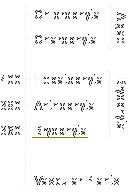
Mosses like the other
bryophytes are an ancient group of simple plants dating back some 360 million years. After the vascular plants, mosses are the most diverse group of plants consisting of approximately 10,000 species in 700 genera.
Mosses are found throughout the world in moist shady locations, except in salt water, and vary in size from 1 meter down to less then 1 mm. Mosses play an important role in breaking down exposed
substrata, and releasing nutrients for use by other more complex plants. They also aid in soil erosion control by providing surface cover and by absorbing water.

Mature mosses have two main growth forms:-
Upright
Erect form - usually erect, sparsely branched, mosses with
sporophyte at the apex of a main axis. Their leaves arise spirally from a stem-like axis, and are rarely notched or lobed.
Prostrate
Prostrate form - usually prostrate, much branched moss, with the sporophytes borne on short lateral branches.
Mosses are classified into three main classes, all of which are represented here in New Zealand. These are
sphagnum mosses, the
true mosses and the
lantern mosses.
Sphagnum Mosses (Sphagnopsida)

Sphagnum is one of the few mosses that is commercially harvested, being used by gardeners as a growing medium as well as packaging material for transporting delicate plants. Sphagnum leaves have hollow cells in which they absorb water; this gives them the ability to hold twenty times of their own weight in water.
True mosses are bryophytes that are real mosses and not other life forms that are just called mosses; e.g. Irish moss (a red algae), club moss (a vascular plant) and Iceland moss (a lichen).
Lantern mosses are a small basal group of mosses commonly found growing on exposed rock surfaces. They are able to cling to the rocks by their
multi-cellular rhizoids


 Mosses like the other bryophytes are an ancient group of simple plants dating back some 360 million years. After the vascular plants, mosses are the most diverse group of plants consisting of approximately 10,000 species in 700 genera.
Mosses like the other bryophytes are an ancient group of simple plants dating back some 360 million years. After the vascular plants, mosses are the most diverse group of plants consisting of approximately 10,000 species in 700 genera. Mature mosses have two main growth forms:-
Mature mosses have two main growth forms:-
 Sphagnum is one of the few mosses that is commercially harvested, being used by gardeners as a growing medium as well as packaging material for transporting delicate plants. Sphagnum leaves have hollow cells in which they absorb water; this gives them the ability to hold twenty times of their own weight in water.
Sphagnum is one of the few mosses that is commercially harvested, being used by gardeners as a growing medium as well as packaging material for transporting delicate plants. Sphagnum leaves have hollow cells in which they absorb water; this gives them the ability to hold twenty times of their own weight in water.